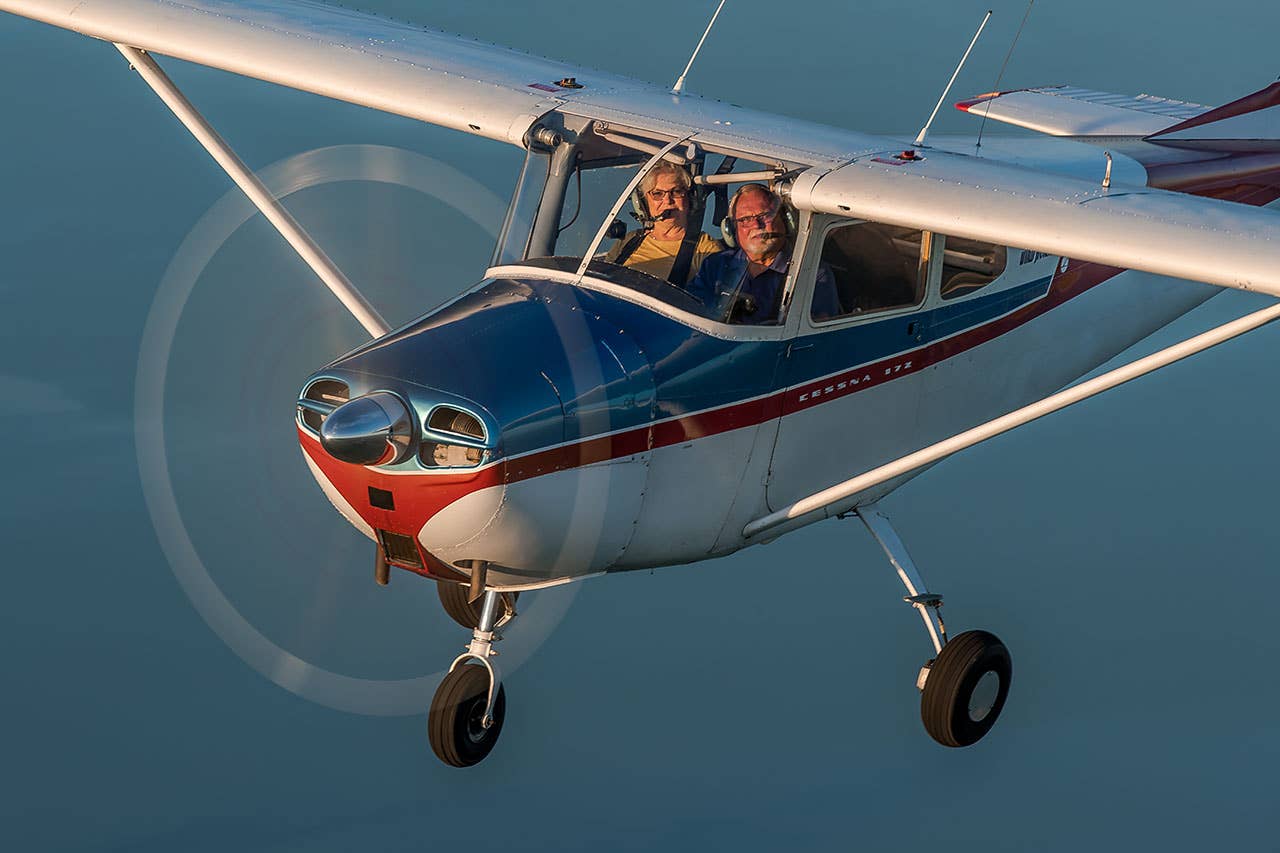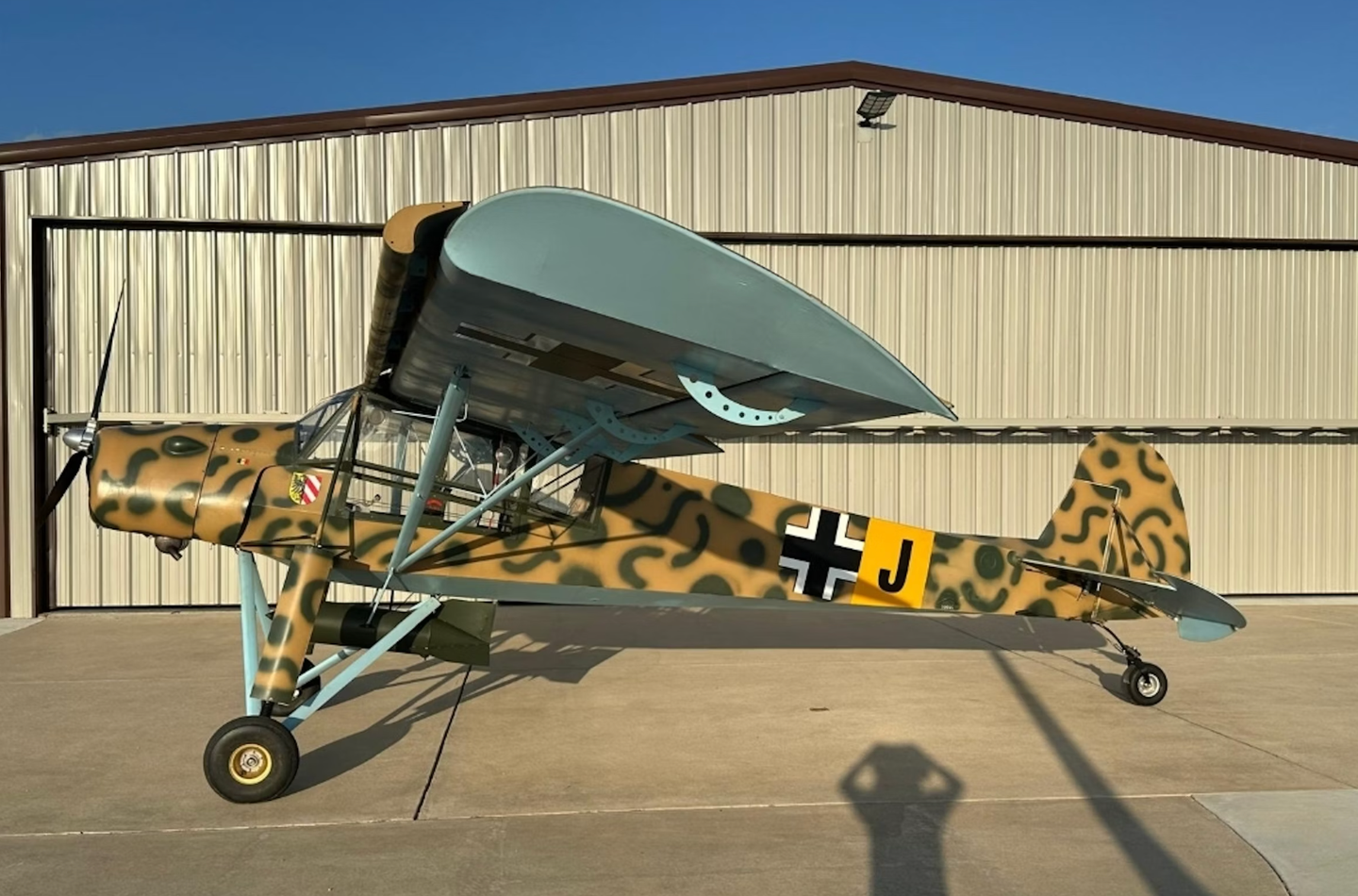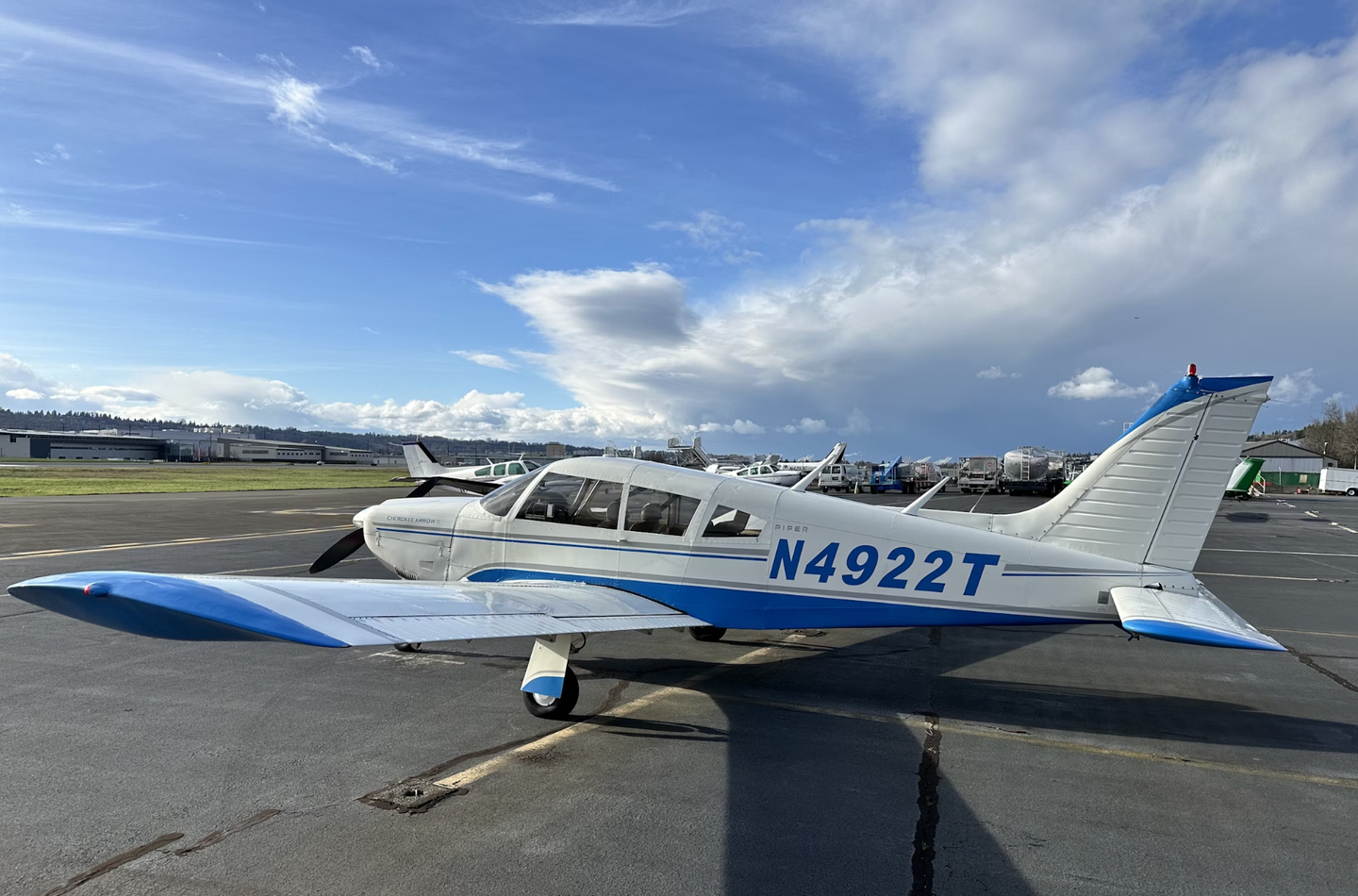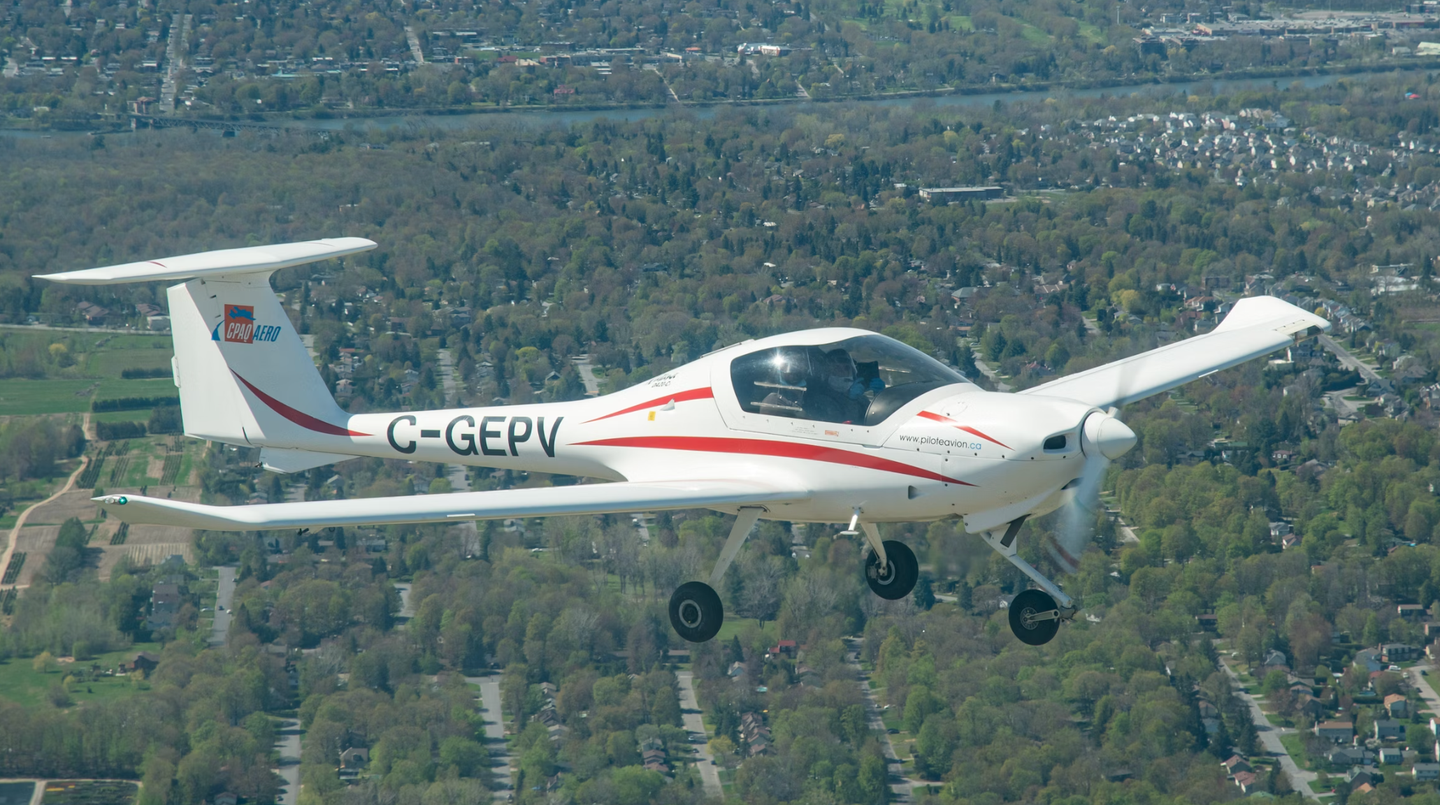Cessna 172: Secrets Of The Skyhawk
Just about every pilot has flown a Skyhawk at least once. But in this new world of aviation realities, is this four-seat, single-engine icon still relevant?

Cessna 172. Photo by Jack Fleetwood
In terms of sheer numbers, the 172 is the most-produced plane in aviation history, making it, hence, the most popular Cessna ever. Numbers don't lie, or at least they're not lying in this case. So, the 172 must occupy the most legendary of lofty places in Cessna lore, right?
But such isn't the case---not even close.
For the skeptical, let me ask a follow-up question: What's the best-loved Cessna ever? I doubt that you jumped up and proclaimed, "The Skyhawk is!" Answers to that question usually cite the stately art-deco Cessna 195 or maybe the sleek and speedy Cessna 310 twin, possibly the cantilever-winged beauty Cessna called the Cardinal, or maybe even the rugged-and-ready Cessna 185 taildragger, all of which have rabid followings online and hugely popular fan clubs, too.
This isn't the case with the 172, and for reasons that are actually pretty easy to pin down, though, again, no one really talks about any of them.
Oh, and a quick note here before aviation history buffs blow a cylinder: For the record, before 1961, there were no Skyhawks, just 172s, as the "Skyhawk" name wasn't introduced until the turn of the decade, and then only as a branding term to highlight the fancier paint and decor of some 172s. At some point, even Cessna started calling them all "Skyhawks," and today, almost everyone calls 172s of any vintage a Skyhawk or a 172 interchangeably, regardless of the trim level or model year. We'll adopt that shorthand, as well.
So, what's left to say about the Cessna 172 Skyhawk, the most-produced aircraft in history, one that has, as a model, amassed untold millions of hours behind the hands and (sometimes) feet of hundreds of thousands of pilots skilled or not-so-skilled? What more can be said about a plane that's so ubiquitous that it makes up a big part of the very fabric of light plane aviation?
What remains to be said, as it turns out, is just about everything. That's because the Skyhawk is so profoundly unremarkable that it seems to defy close inspection, like the perfectly average-looking person who tends not to get spotted in the crowd. They seem invisible because there's absolutely nothing noticeable about them. That doesn't mean there's anything wrong with them---quite the opposite. Their average appearance is a kind of perfection.
It's a form of beauty that tends to go unnoticed, though. A former colleague once described flight reports on the 172 as somniferous. (Or it might have been "soporific" or even "soporiferous;" it's been a few years.) The point was, such reports will make you sleepy. The act of flying a 172 might get you there, which, when it comes to an airplane aimed at no-time to low-time pilots, isn't a bad thing---not the sleepy part, but, rather, the easy-to-fly part.
The reason it's hard to write about the 172 is that flying one is memorable mostly in that the act of flying is memorable, so it follows that if you're flying a Skyhawk, it's memorable, though probably not because of the airplane. So, unless stories about flying 172s are about the flying as much as or more than about the airplane, it's hard to see the point.
The truth is, I'm simply not sure what, in the grand scheme, to make of the 172, not the myth or the monolith but the airplane itself, the wings and windows and nosewheels, the flying manners of it, which is to say, the airplane itself divorced from its story.
Flying 172s
It's not like I haven't had the chance to get to know the 172. I've flown maybe 50 different Skyhawks of different vintages, configurations and engines. I've flown fastback straight-tailed late-'50s bare-metal 172s and FADEC-equipped turbodiesel Skyhawks with flat panels splayed across the panel and seat tracks designed by NASA. I've flown 172s on floats, and with retractable gear, with more powerful engines with four cylinders and less-powerful ones with six jugs; I suspect that at some point, I'll get to fly an all-electric Skyhawk.
It's not that the Skyhawk is a bad flying airplane. Again, quite the opposite is true. One could make a convincing argument, in fact, that with the 172, Cessna built the epitome of the flying machine, that in the 50-some-odd years between the Wright Flyer and the Cessna 172, no one had gotten it quite right before Cessna. And it has only gotten more perfect, a line so skillfully executed that the human eye can't find a flaw.
After all, what airplane is more automatic to hand-fly than a Skyhawk? Which model is smoother, has more perfectly harmonized flight controls, a more intuitive feel? Which one is more forgiving? What plane makes you look better?
Arguably, in each case, the answer is no otherairplane.
And yet, the Skyhawk's flying manners are kind of forgettable. When's the last time you heard a pilot come back from a flight in a 172 and proclaim, "What a great flying airplane that is!" Probably never. But that's not a bad thing. In fact, it might be the very best thing. I'd argue that the reason that a Skyhawk's flying manners are so forgettable is that the plane is the very definition of flying. It's what flying feels like, in much the same way that air is what breathing feels like. You don't say, "That's darned good air," but I think we can all agree that Mother Nature pretty much nailed that particular gaseous mixture.
I don't think that it's familiarity that makes us think that the 172's flying manners are divine. I think it's because they just are. I have to admit that just about every different model of airplane I've ever flown, hundreds of them, I compare to the Skyhawk, usually very consciously so. Is it silly to compare the Gulfstream G650, a Mach .925 intercontinental fly-by-wire business jet, to the Cessna 172? Not at all. In fact, if I were to put together a list of the best-flying airplanes I've ever had the pleasure to fly, those two planes would be in second and first place, respectively.
The truth is, the Skyhawk's flying manners are close to perfection. It's not too heavy in feel or too light (though it leans in that latter direction). Likewise, it's a stable airplane, but not too stable, which is both possible and, ultimately, undesirable. While pilots often say that more power is always better, it's not always the case. I'd argue that 180 hp, the current power rating for the Skyhawk, is perfect for it, though the plane did just fine most days in most places with the original 145 ponies.
Why So Many Skyhawks?
Today, we think of the 172 as a training airplane, but for at least the first 30 years of its existence, that wasn't the case. It was a personal airplane that could do double duty as a utility plane, pipeline patrol, maybe some flight instruction, though seldom at multi-airplane flight schools. It was what it was, and Cessna didn't mess with that recipe much for decades, because why would it? Throughout the 1960s, Cessna was selling a thousand Skyhawks a year, and by the mid-1970s, it was turning out almost 2,000 every year.
Not only did customers clearly love the 172 as it was, but the model was bookended by two others popular in their own right---the 182 Skylane and the 150/152.
The 182 is more airplane than the 172 by a good margin. With a 235 hp Continental six-cylinder engine (compared to the 145 hp Continental six in the 172), and with a beefier airframe, the 182 could haul more and fly farther, too. Still can.
Down market from the 172 was the 150, which morphed into the 152 in 1978. The 150 was a training airplane, plain and simple, a two-seater that wasn't fast and couldn't fly very far. It did get used as a personal airplane, which is still the case, but the vast majority were bought to be used for flight instruction because they were cheaper to buy and cheaper to operate, and they got the job done nicely.
So, making the 172 more capable would have impacted sales of the 182, which was also a hot seller, and of the 150, which, ditto. The 172 remained the same somewhat capable, somewhat useful four-seat (kind of) personal plane, in essence, the perfect compromise between utility and economy.
Another thing to remember is that while the difference of a few thousand dollars, which was the delta between Cessna models for decades, might not seem like much these days, you need to think more in ratios than dollars. The difference in prices between the models was designed to force buyers to spend only as much as they could possibly afford to step up. Which they did in great numbers.
Back to my point: The 172 is still being produced and sold in good numbers by Textron Aviation's Cessna Aircraft division. Overall, it's cranked out around 45,000 172s. It delivered 126 of the 172-S, the only model in production right now, in 2019, many of those going to larger flight schools in fleet deals. Just how many were purchased by individuals for their personal use is unknown, but considering the Skyhawk's hefty price tag of between around $375,000 and $435,000, it has to be a small number. With a full glass cockpit, stylish and comfortable interior, and safety improvements across the board, today's Skyhawk is a premium product.
Such was not always the case. In the early days, the 172 was the Volkswagen of the skies, a simple, easy-to-fly, all-metal four-seater that didn't require deep pockets or exceptional stick-and-rudder skills to fly. Remember, too, that the 172 was originally a nose-gear version of the taildragger 170. Preproduction interest in the 172 was so great that Cessna discontinued the taildragger 170 right around the time it introduced the 172. Nosewheels weren't new---Beechcraft's Bonanza had been hot stuff for a decade already, and Piper's Tri-Pacer sold well. But the 172 was a truly modern entry-level four-seater with a nosewheel. You didn't have to be the best pilot at the patch to fly these new planes, though it wouldn't hurt if you were.
It's interesting to me that not many of the most-produced planes in history are personal planes. There are a few clustered toward the top, none of which would surprise you, but of the top 20, only six are personal airplanes. The others, as you might have guessed, are all planes built to go to war. Even some of the small planes on the list had their numbers greatly aided by the war effort. Of the 20,000 or so Piper J-3 Cubs built, more than 6,000 of them were built for military use.
The military version of the 172, the T-41 Mescalero, on the other hand, was produced in much smaller numbers. Over the course of 32 years, from 1964 to 1996, Cessna built just over 750 T-41s, but even by the year of its introduction, there weren't big bucks to be made in the sale of small military planes. The model's success is due almost entirely to its appeal to private pilots, which is huge, though for reasons that aren't always entirely clear.
The 172"¦Trainer?
Cessna ended production of its single-engine airplanes, all of them, in the mid-1980s and restarted it about a decade later. When it did, it reintroduced only a handful of its former models; the 172 and 182 made the cut, but the 152 did not. So, the lowest-cost Cessna became the 172. It also became the de facto training leader.
No one thought it was a perfect solution. In fact, in 2006 Cessna announced a lower-cost two-seat LSA trainer, the Cessna 162 Skycatcher, a two-seat light sport plane that it hoped would fill what was then a growing need for an economical trainer. That need was generated in large part by the cancellation of the company's 152 (nee 150) 20 years earlier. A new two-seat training plane was, and is, a great idea, because flight schools need a plane that's a lot cheaper to buy, fly and maintain than a conventional four-seat Part 23 trainer.
Of course, for a few decades, the 150/152 was that plane, but as time passed and production costs rose, it became too expensive for Cessna to make a profit at it. At least that was its calculus when it decided not to reintroduce the plane when it restarted production of the 172 (and 182 and 206) in 1997.
But the Skycatcher Light Sport was a rare failure for Cessna, and it was a spectacular one, too, a plane that didn't fly as well as hoped, was years behind schedule, cost $50,000 more than its original target price of $99,000, went through major design changes, including a mid-program engine swap, and was subject to an expensive airworthiness directive to beef up the structure of the plane's wing (a repair that Cessna paid for).
So when, in 2013, then-new Cessna CEO Scott Ernest pulled the plug on the Skycatcher, it was no surprise. Also, the 172 became once again Cessna's de facto training platform.
The company hasn't announced any interest in a two-seater since. It doesn't really need such a model; one could argue, however, that it didn't need it in 2006, either. There was and is little competition among traditional aircraft makers for the sales of training aircraft of any description. Piper, Cessna's biggest competitor, explored an LSA option too, but, like Cessna, abandoned it, though before it hadn't yet made much progress or spent much money on it. Like Cessna, Piper defaulted to its PA-28 four-seat Archer, which is a near-twin of the 172 in terms of performance, operating costs and market appeal.
The other bookend, the higher-priced, higher-performance Cessna, is the 182 Skylane, which, as mentioned, Cessna reintroduced in 1997 and is a steady if unspectacular seller at a base price of $565,000 for the turbocharged single. (Cessna isn't offering a naturally aspirated 182 at present.) The Skylane is a lot more airplane than the Skyhawk in every way, and, with its price around $150,000 steeper than the 172's, there's clearly no room for a faster, more powerful Skyhawk; Cessna already has such a plane.
Skyhawk Assassination Plots
For an airplane that sold in huge numbers for the first 30 years of its existence and at lower but steady rates since its mid-'90s comeback, the Skyhawk has suffered no shortage of disrespect over the years, even to the point of Cessna trying to replace it with new, updated models.
Although Cessna never positioned it as such, the first attempt at replacing the 172 arguably came a few short years after the 172's launch, when Cessna introduced what was, in many ways, a better Skyhawk, the Model 175 Skylark. The 175 had just the right amount of extra, well, extra everything---speed, power, carrying capacity and more. It coulda been a contenduh.
What did it in was the 175 hp geared engine it sported, the Continental GO-300-A. The powerplant turned out too fussy about how one operated it---pilots needed to cruise it at its book setting of 2,900 rpm lest the need for an overhaul come at 300 hours instead of the already-short TBO of 1,200 hours. Cessna even went so far as to name later iterations of the plane the Skyhawk Powermatic in hopes that by copping its largely trouble-free stablemate's handle, it might alleviate buyers' concerns. It didn't. The Skyhawk endured, and the Model 175 Skylark went away.
The next attempt was in 1968, when Cessna tried expressly to replace the Skyhawk with the Cessna Cardinal, a plane that many think is the prettiest Cessna ever, a claim I wouldn't argue. The problem with replacing the Skyhawk, as I've suggested, is that despite it not being sexy or particularly pretty, it's an awfully good airplane to begin with and an even better first plane than that. Once the company shared its plans, there was what could be described as a popular uprising, the biggest show of respect, arguably, ever given the 172. Dealers wanted to keep the 172; customers, too. And remember, the Skyhawk was selling on average more than a thousand units a year.
By the time Cessna rolled out the Cardinal, just 12 years into the 172's production run, Cessna had already sold more than 12,000 172s, so it was hard for many to see the logic of discontinuing the 172. It didn't help that the Cardinal had issues upon its introduction. Cessna had to redesign the horizontal tail after pilot-induced oscillation accidents, and it had to boost the horsepower of the engine after the near-universal complaint that it was underpowered, even though it was slightly more powerful than the Skyhawk. So instead of the Cardinal replacing the 172, it became a second model. And while there's a common misconception that Cessna ended Cardinal production when, in 1986, it retired its entire single-engine piston line, that wasn't the case. Cessna pulled the plug on the Cardinal eight years earlier, in 1978, amid sluggish sales.
Sluggish sales weren't much of an issue with the most successful Skyhawk update, the Hawk XP, which featured a 195-hp Continental engine and constant-speed prop. It was certificated under the 175 Skylark type certificate. It was initially popular, but when GA tanked in the early 80s, its fate was sealed, along with the rest of Cessna's piston single-engine lineup.
Another, later palace coup was the launch of the Cessna NGP (the initials standing for "next-generation propeller," a name that struck us as odd because, presumably, the whole plane and not just the propeller came with purchase). Cessna announced the program at Oshkosh 2006 and even flew one to the show. It wasn't going to be just an airplane but, rather, a family of airplanes for everything from training to personal transportation and more.
Over the next few years, there was little said about the NGP, though Cessna did indicate upon purchasing the Colombia 400 program that it planned to keep going with the NGP. But after another couple of years, the NGP was no longer being mentioned by the company, until it was withdrawn from the conversation altogether, a decision for which Cessna offered vague or no answers at all. Rumors abound about the design, but they are just that, rumors. Cessna has been mum on the subject.
And once again, the Skyhawk endured.
All Skyhawks Are The Same (And Other Lies)
For an airplane that's been around for 64 years (sing along, "When I get older!"), the 2020 172 Skyhawk is remarkably similar-looking (and flying) to early 172s. But in those 64 years, Cessna has made a lot of improvements to the model, though some folks are quick to point out that those improvements come with two major adverse side-effects, higher prices and a heavier plane. A 2020 Skyhawk's basic empty weight of 1,680 pounds is 420 pounds greater than the empty weight of the 1956 model, though today's 172 has a 330-pound edge in maximum takeoff weight. So, an original 172 has a 62-pound advantage in useful load. It's not nothing.
What that slight decrease in useful load buys, however, is, if not priceless, then close to it. During its production life, just about every Skyhawk component has been improved, upgraded or replaced altogether. A very partial list of what's better would include the seats and seat tracks, the flaps (though some do pine for the Johnson bar manual flaps---I'm a fan myself), the windows, the paint both inside and out, the interior, the avionics and the landing gear. The new Skyhawk can fly faster and go farther. It's quieter inside and out, and it's far more comfortable to fly in, too. Compared to a 2020 model, the 1956 172 is a primitive machine. It still flies great, though.
It does fly differently, admittedly, and even though the feel is less refined than that of today's Skyhawks, a pilot familiar with the 172 could fly an early model blindfolded and still tell that it was a 172, especially in the landing phase.
What's on the horizon for the Skyhawk? Well, Cessna has tried and failed to find a satisfying diesel version of the plane; I've flown both of Cessna's diesel-powered proof of concept planes, the TD and the JT-A, along with two other aftermarket attempts to mate Jet A with the 172, and they all flew okay but were begging for more power, which wasn't available at the time. It's possible that Cessna will introduce another attempt at a diesel Skyhawk---it's a natural---but if it's working on something, it's keeping quiet about it.
And you might have heard that in 2010, Cessna flew a proof-of-concept all-electric Skyhawk, but it wasn't a part of any ongoing Cessna development program, and nothing more came of it. Which isn't terribly surprising, as the four-seat Skyhawk is carrying a lot of weight. And while weight is the enemy of every airplane, it's the archenemy of electric aircraft, which need as much help in stretching the endurance of their batteries as possible.
Until the future gets here, whenever that is, we've got the regular Skyhawk, a sheet-metal four-seater powered by a gas-piston engine that is remarkable for how perfect a compromise it is in every way, a fact that puts it on a perch that no one seems to pay much attention to but that customers, mostly larger flight schools, keep adding to their shopping carts.
The punchline is, despite so few pilots being gaga over the Skyhawk, it endures and continues to sell in numbers that keep Cessna happy with its continued spot on the production line in Independence, Kansas.
And even though not many private flyers are buying a new Skyhawk, lots of them are learning to fly in the plane, which is the most popular trainer in the world today. In that important way, the Skyhawk is indeed the first airplane for tens of thousands of pilots a year, and thousands of instructors happily ply their trade in the great old bird, perhaps seldom waxing poetic about it but at the same time, strangely enough, never complaining about it, either. Considering how much people like to complain, that's a pretty powerful testimony, if you ask me.
So, what's the future of the most-produced if not best-loved Cessna of all time, that perfect-flying, ideal compromise between power and restraint, the Cessna Skyhawk, a 64-years-old-and-counting icon of flight? The conventional wisdom is that it's reached the end of its product cycle, that great minds will brew up innovative approaches to accomplishing the remarkable things the Skyhawk has achieved, and soon, too. It's exactly what Cessna thought in 1959, in 1968 and again in 1997 (and which it might be thinking about as I write).
And we all know how those attempts to retire a perfect airplane worked out. And once again, the Skyhawk endures.

Subscribe to Our Newsletter
Get the latest Plane & Pilot Magazine stories delivered directly to your inbox






